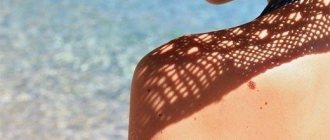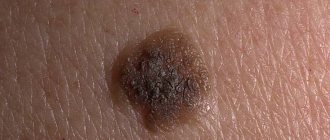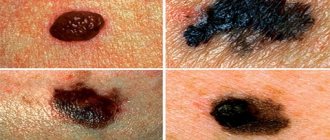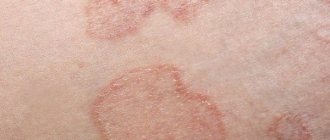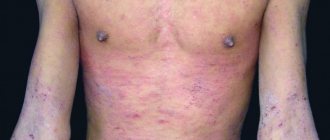Melanoma is a malignant tumor into which moles, common warts, and birthmarks can transform. The degeneration of a mole into melanoma (photos are available on the Internet) occurs under the influence of provoking factors and takes a certain time. Oncologists at the Yusupov Hospital, when the patient contacts the patient in a timely manner, conduct a comprehensive examination and quickly establish an accurate diagnosis.
For melanoma, surgical intervention is performed in compliance with the principles of ablastics, treatment is carried out with the latest antitumor and immunomodulatory drugs, and radiation therapy. When there are symptoms of melanoma - moles, patient management tactics are developed collectively. If a mole is removed in a timely manner, signs of melanoma do not occur.
Why do moles appear?
Modern doctors identify the following reasons for their occurrence:
- Genetic predisposition - often children have approximately the same number of moles as their parents. In this case, a similar birthmark may appear in the same place for several generations in a row;
- During periods of hormonal changes, a larger number of birthmarks appear (up to 24 years). Most often this occurs in adolescence, during pregnancy, after childbirth, abortion, when taking hormonal contraceptives, at the age of 45-55 years, after serious stressful situations. The last period must be monitored especially carefully;
- Sun rays and other radiation - in different areas they stimulate the appearance of new nevi in different ways. They begin to appear in the form of freckles, after which they increase in size. Fluorography and x-rays can also provoke their appearance;
- Trauma to the skin cannot, of course, cause the appearance of new moles. Damaged areas during this period are more susceptible to the influence of various radiations. The chances of infection entering the body also increase. During this period, melanocytes are activated, grouped and come to the surface;
- There is a greater chance of moles turning into melanoma in those who have a significant number of birthmarks, fair skin and are prone to the appearance of freckles;
- Age - malignant neoplasms on the skin can appear not only in youth, but also in old age. The skin of such people is more susceptible to external factors.
Which moles are dangerous?
Any birthmark can quickly develop into malignant melanoma. This happens very quickly, which is why it is so important to monitor moles on your body and look for suspicious spots or changes.
There are 3 types of nevi that are most susceptible to malignant degeneration:
The main reasons for their degeneration are considered to be excessive exposure to ultraviolet rays or mechanical trauma. People with fair, sensitive skin are especially at risk.
The following types and changes in moles also pose a particular danger:
- Lentigines are flat birthmarks on the skin that are slightly raised on the skin (or not raised). They have a brown tint, black spots are possible, sizes up to 3.5 cm. It can be either congenital or appear suddenly. Doctors classify it as a dangerous species because it degenerates very quickly. They appear mainly on the palms, soles, neck and face, which exposes such areas of the skin to greater exposure to external factors;
- Epidermal nevi are compactions of a light brown hue. The most common location is the palms or genitals;
- Complex formations - noticeably rise above the skin, dark-colored formations.
- Nevi, which are surrounded by discolored areas of skin similar to vitiligo patches. Either one such nevus or several can form simultaneously. Doctors say that such symptoms can be the beginning of an unpleasant degeneration of a birthmark.
Lentigo Epidermal nevi Complex formations Nevus with a colorless area
Special attention should be paid to changes on the skin in children.
Parents should pay attention to changes in the following types:
- Red nevi - formed in places where skin and clothing rub against each other;
- Flat moles - they are mostly congenital and can increase with age; it is advisable to remove them;
- Common nevi are brown moles that can appear throughout life. In most cases, they do not pose a risk to children's future health;
- Hemangiomas are neoplasms with which children are born. May have different structure and color;
- Huge nevi are the most dangerous spots on the skin of children. They can even occupy part of the body. The degree of their degeneration into melanoma is very high and is about 10%.
Etiology of the disease
In most cases, a warty nevus develops in the womb (at 15-20 weeks of pregnancy) and the baby is already born with this disease. Much less often, the disease develops in childhood or adolescence. The likelihood of developing the disease increases if relatives also have this disease. The occurrence of nevus among adults or elderly people is rare.
The exact cause of the manifestation has not been established. Presumably, the development of the disease is influenced by the following factors:
- Disturbances in the normal structure of the skin.
- Hormonal changes.
- Genetic disorders.
According to statistics, in 70% of cases the disease develops in females.
When should you visit a specialist?
The reasons for contacting a specialist about a nevus or mole can be different:
- cosmetic defects;
- discomfort in everyday life;
- unpleasant symptoms of degeneration into melanoma.
Mandatory reasons for visiting a doctor should be:
- changes in nevus parameters;
- number of moles;
- their noticeable increase over the last period;
- change in the outline of a mole;
- discharge of fluid or blood from the spot.
You should be concerned if all the changes happen very quickly.
Symptoms of degeneration
Everyone needs to know them in order to promptly notice the transformation of an ordinary mole into melanoma:
- The color of the mole has noticeably changed . They may become lighter, darker, or even blacken;
- Different shades and signs of peeling appeared on the mole;
- The boundaries of the tumor have become unclear , spread out, and the skin around it may turn red. Before this, the flat spot becomes noticeably convex and rises above the surface of the skin. This is an alarming signal of the beginning of the inflammation process;
- Formations in the form of nodules or crusts appeared on the spot;
- At the site of rebirth, unpleasant sensations appeared: peeling;
- itching;
- pain;
- tingling;
Possible complications
If you ignore medical recommendations, regularly injure yourself, or try to self-medicate, a mole can cause:
- squamous cell skin cancer;
- bacterial eczema;
- pustular infections;
- destruction of nail plates.
The complication is provoked by ultraviolet radiation, injuries, scratches and friction. Damage to the skin around the tumor increases the risk of developing inflammatory processes, with their further spread to nearby areas. This applies to a greater extent to moles located in the armpits and groin. Due to the addition of infection, diaper rash surfaces acquire a specific pungent odor.
Moles located on open areas of the body cause serious psychological discomfort to the patient. Some forms of neoplasm cover a significant area of the skin, affect the hands and feet, and cause destruction of the nails.
Which doctor should I contact about a mole?
If suspicious moles appear, do not hesitate; it is better to consult a doctor immediately. Basically, the doctor’s choice depends on what needs to be done with the mole, whether it is growing, how the color and size have changed.
Visit to the dermatologist
It is this doctor who is the first person to be contacted to examine moles.
A visual examination is carried out, the doctor collects the patient’s medical history and prescribes the necessary diagnostic tests. At the first examination, you can not only assess its size, color and shape, but also its malignancy.
If the reason for the visit is damage to the birthmark, then medication therapy or other alternatives will be prescribed. In the future, you should definitely monitor the symptoms until the wound heals completely.
If there are signs of malignancy, the doctor will definitely prescribe additional studies and examinations by other specialists.
To determine the nature of the birthmark, a dermatologist can conduct the following studies:
- Dermatoscopy – performed using a dermatoscope. A special medication is applied to the area of skin being studied and their interaction is studied;
- Histology - a substance is applied to the removed part of the mole that will color it and examined under a microscope;
- Biopsy - the material is studied in a special laboratory. Its collection is carried out by puncture or excision;
- Computer diagnostics - using a special digital video camera, a specialist studies the nevus in detail and its changes in the near future.
Why go to a surgeon?
Removal of a mole is carried out in case of malignancy or mechanical damage. Only the doctor decides whether to remove it or not, after receiving the results of all examinations and a referral from a dermatologist.
Mole removal is most often carried out using the following methods:
- Removal using a regular scalpel . The method is not painful, but there is a high risk that a noticeable scar will remain on the skin;
- Cryodestruction . Removing moles under the influence of low temperatures. The doctor uses liquid nitrogen or dry ice for cauterization;
- Electrocoagulation . New growths are eliminated using current. There is almost no blood loss, since the vessels are soldered;
- Laser therapy . The simplest, most accessible and effective method. The number of relapses and scars after its use is minimal.
Removal with a scalpel Cryodestruction Electrocoagulation Laser removal
When should you contact an oncologist?
A dermatologist can refer you for a consultation to an oncologist, who will conduct special tests for the malignancy of the formation and histological studies.
Depending on the result, radiotherapy or chemotherapy will be prescribed. It is advisable to go to the oncologist with the results of the biopsy and histology.
Specialist doctors
In addition, you may need to consult specialists such as:
- Examination by a therapist - he necessarily measures all parameters, determines the patient’s condition, examines for the presence of an inflammatory process, and makes sure that all necessary additional tests are completed;
- An oncologist - mammologist - is most often visited by women if the mole is in the chest area. He decides on further actions, it is so dangerous for the patient’s life;
- Support from a psychologist - often people who have discovered pathological changes in moles have to turn to him. For successful treatment, it is important to maintain emotional balance and avoid stress.
Diagnostics
In the process of diagnosing nevi, the doctor uses both standard methods (history collection, visual examination) and instrumental diagnostic methods. In this case, studies such as dermatoscopy, biopsy and histological analysis of the mole are highly informative.
Dermatoscopy
The essence of the dermatoscopy method is to examine the skin under magnification. During the examination, the doctor evaluates the color and structure of the epidermis, identifies the main characteristics of skin rashes, examines the epidermal-dermal junction and the papillary layer of the dermis.
To perform the study, a special device is used - a dermatoscope. This device may resemble a small magnifying glass (manual dermatoscopy) or be a special device that can be equipped with a digital photography function with the possibility of subsequent detailed, even computerized, analysis of various skin structures.
The dermatoscopy method is simple and accessible, but at the same time very informative. Examination of moles by a doctor using a dermatoscope significantly increases the chance of detecting malignant skin tumors, primarily melanoma.
Can the problem be solved by a cosmetologist?
You should contact a cosmetologist about a mole only if you need to properly disguise it.
Doctors name reasons why it is not advisable for cosmetologists to treat and examine nevi:
- A qualitative diagnosis of a suspicious birthmark can only be carried out by a doctor, but not by a cosmetologist. It is not the responsibility of cosmetologists to do their research;
- Often cosmetologists do not have special medical education, so they do not have the right to prescribe treatment;
- If a mole enlarges or other parameters change, it should not be masked; this is a reason to seek help from a dermatologist, surgeon or oncologist.
In any case, at the first unpleasant symptoms of the degeneration of a mole, it is not recommended to waste precious time on pointless visits to a cosmetologist who cannot prescribe proper therapy.
Why is a warty nevus dangerous?
Warty nevus is not classified as melanoma-hazardous, that is, the risk of its malignancy is low. But this does not mean that such a convex mole cannot be reborn at all. In the presence of provoking factors, it can cause the development of skin cancer.
When answering the question of why a warty nevus is dangerous, it is worth mentioning its high sensitivity to mechanical, chemical, and thermal effects. The reaction to the stimulus is tumor growth. The more often it is injured, the more it increases in size.
Moles are prohibited:
- scratch;
- to scratch;
- cutting down;
- cauterize;
- freeze.
In addition to tumor growth, these actions increase the risk of infection and the development of inflammatory processes.
FAQ
Who should I contact to remove a large birthmark?
Not all moles or birthmarks degenerate into malignant melanomas.
But large birthmarks can cause discomfort.
Many consider them a cosmetic defect and want to remove or significantly reduce them.
The removal procedure itself is performed by a surgeon.
But before the operation, you need to pass the prescribed tests, visit an oncologist and a dermatologist, who will assess all the risks and conduct the necessary studies.
The removal method depends on this.
Prevention measures
To slow down the process of their appearance or reduce the risk of degeneration, you should adhere to the following recommendations:
- In summer, avoid being in direct sunlight from 10.30 to 17.00;
- Remember about the accompanying factors that can provoke a double effect of skin absorption of ultraviolet radiation - water, sand, snow;
- Remember that even the most expensive sunscreens do not provide 100% protection from solar radiation;
- Avoid or significantly reduce your time in the solarium. This is especially true for people over 35 years of age;
- Make sure that they are not subject to mechanical damage or friction.




